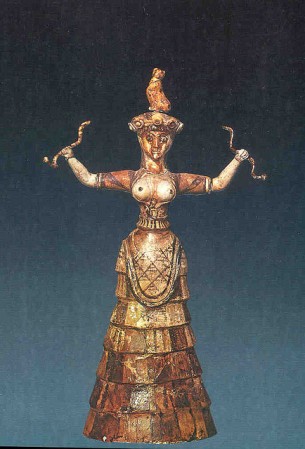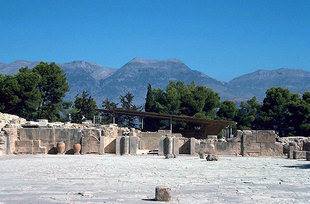
The words we use affect our thinking. In the case of ancient Crete the repetition of the terms “Palace,” “Palace of Knossos,” “King Minos,” “Minoan,” “Priest-King,” and “Prince of the Lilies” shape the way we understand history–even when we ourselves know these terms are incorrect. We must engage in “new naming.”
Ariadne. May have been a name of the Goddess of pre-patriarchal Crete. The ending “ne” signifies that Ariadne is not of Greek or Indo-European origin and thus predates the later Greek myths.
Ariadnian. The name I have given to the Old European pre-patriarchal culture of Crete, from arrival of the Neolithic settlers from Anatolia c.7000 BCE to the Mycenaean invasion c.1450 BCE. Arthur Evans named the Bronze Age (c.3000-1450 BCE) culture of Crete “Minoan” after King Minos of Greek mythology, son of Zeus and Europa, husband of Pasiphae, father of Ariadne, whose gift of the secret of the labyrinth to Theseus led to the downfall of her culture. Evans assumed that Minoan Crete was ruled by a King.
This image I call “Ariadne Dancing” could become the new “icon” of Ariadnian Crete.

It could and should replace the “icon” of the “Priest-King” Arthur Evans’ “imaginatively” reconstructed and named the “Prince of the Lilies.”

Once we remove the crown which probably belonged to a Sphinx, the figure’s white color and athletic body suggests it was intended to portray a young female bull-leaper leading a bull.
A-sa-sa-ra. A name found in pre-Indo-European Linear A libation formulas and thought to be a name of the Goddess. Its similarity to the names Asherah, Ishtar, and possibly Isis, led to the suggestion that this name was brought to Crete c.3000 BCE by new settlers who also brought the bronze smelting technology. However, it is possible and not unlikely that the name came to Crete with the original settlers from Anatolia, especially since unlike her counterparts in the Middle East, the Ariadnian Goddess was not subordinated to a Father God.
Could Asasara be the name of the Snake Goddess?

Bronze Age. Defined by the smelting of bronze, but not yet iron.
Ida-Mate. A name found in Linear A, the undeciphered non-Indo-European language of Bronze Age Crete, thought to be a name of the Goddess as Mother Ida, Moutain Mother of Mount Ida.
Ida Mate appears as twin peaks or breasts when viewed from the Sacred Center of Phaistos.

Incubation Chamber. A small underground room entered by a series of steps in an “L” shape. The chamber could made dark or light through the use of shutters on an upper level, and it would have been possible to look down into the chamber from above. There was usually a small square ritual area in front of the steps leading down. May have been used for initiation, prayer, sacred dreaming, healing, or even giving birth. Found in the Sacred Centers and in smaller buildings. Arthur Evans called these rooms “Lustral Basins” (bathing chambers) despite the fact that they have no drains.
Indo-European. A group of languages originating in the Russian steppes north of the Black Sea, including European languages (except Basque which is pre-Indo-European and Hungarian and Finnish, which are Finno-Ugric) and Sanskrit. Indo-Europeans invaded Europe in waves from the north, beginning c .4400 BCE. Greek-speaking Indo-Europeans known as Mycenaeans established fortified strongholds in the Peloponnese of Greece by c.2000 BCE. Indo-Europeans domesticated the horse; their culture was patriarchal, nomadic, warlike, and not highly artistic; they worshipped shining Gods of the sky who were reflections of their bronze weapons. The Indo-European Mycenaens invaded Crete c.1450 BCE; their language,Linear B, is an early form of Greek. A different Indo-European group invaded India c.1500 BCE.
Labrys. Double wings, a symbol of the bird Goddess.
Matrilineal. Identity and property pass through the female line, often through the mother clan.
Matrilocal. Daughters and sometimes sons live with their mothers, remaining in the maternal clan for life.
Matrifocal. Societies that honor mothers and values associated with motherhood—love, generosity, and care.
Matriarchal. Scholars define matriarchies as societies where women “ruled” and conclude that they never existed. Heidi Goettner-Abendroth redefined matriarchies as societies that honor motherhood as their first principle. Matriarchies are: 1) generally in the early stages of agriculture with land held in common by maternal clans; 2) economically egalitarian with differences of wealth redistributed through gift-giving; 3) politically egalitarian with power shared by mothers and uncles and in participatory democracy; 4) matrifocal, valuing love, generosity, and caring as the highest values for both sexes, and usually viewing Earth as a great and giving Mother.
Neolithic. New Stone Age, referring to the invention of agriculture (c.8000 BCE in the Middle East) and the change from gathering and hunting to farming. Scholars “concede” that “woman the gatherer” invented agriculture and the other new technologies of the Neolithic, pottery-making and weaving—but do not correlate the invention and probable control of new technologies to female power in society.
Old Europe. The name given by Marija Gimbutas to the pre-Indo-European, pre-patriarchal Neolithic cultures of Europe c. 6500-3500 BCE. Old European cultures were settled, agricultural, artistic, peaceful, egalitarian, matrilineal, probably matrilocal, matrifocal, worshipping the Goddess and celebrating the powers of birth, death, and regeneration in all of life. Crete, at the southern end of Europe, was the last flowering of Old European culture.
Sacred Centers. The name I have given to the complexes called Palaces by Arthur Evans. The Sacred Centers were the ritual heart of the surrounding communities. They were community gathering places and provided communal storage areas for a portion of the harvest and workshop space for the creation of sacred objects from clay, stone, bronze, silver, and gold.
Sacred Horns. Celebrate the importance of cows, bulls, and oxen in Ariadnian society. Horns like bones outlive the flesh and may become a symbol of death and regeneration. The sacred horns symbol echoes twin peaks or breasts of mountains and the upraised arms of women in ritual.
As new names take root in our minds, new interpretations of history will occur to us. As I was writing this blog, something shifted in my mind. I had always “thought of” the ancient Cretans as “individuals” who “for some reason” brought a portion of the harvest to be stored in common. Duh, it just occurred to me that if the land was held in common by the maternal clans then communal storage of the harvest requires no explanation.
By Carol P. Christ, shared with permission from the author. Originally published on feminismandreligion.com
Carol is looking forward to the fall Goddess Pilgrimage to Crete–$150 discount for the next two women to sign up for the fall 2014 tour–www.goddessariadne.org. Carol can be heard in a recent interviews on Voices of the Sacred Feminine, Goddess Alive Radio, and Voices of Women. Carol is a founding voice in feminism and religion and Goddess spirituality. Her books include She Who Changes and Rebirth of the Goddess and with Judith Plaskow, the widely-used anthologies Womanspirit Rising and Weaving the Visions. Follow Carol on GoddessCrete on Twitter.
No comments:
Post a Comment